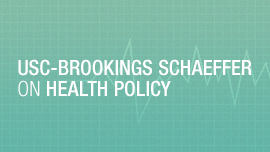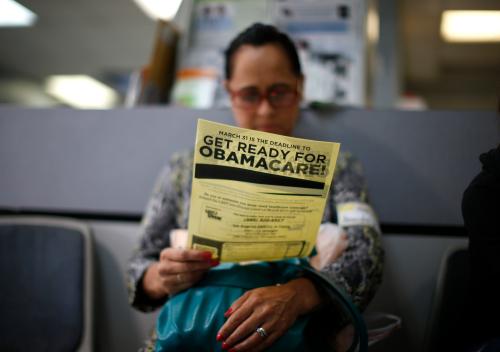On Wednesday the Department of Health and Human Services proposed a series of changes to the rules that govern the Health Insurance Marketplaces established under the Affordable Care Act (ACA). One of the proposed changes would impose more stringent documentation requirements on people trying to sign up for Marketplace coverage through special enrollment periods (SEP), which are available to people who experience qualifying life events like losing job-based coverage or moving to a new area between annual open enrollment periods. The Administration’s stated goal is to improve the individual market risk pool and reduce premiums by preventing fraudulent enrollment through SEPs. But implementing these new requirements without testing them would run a significant risk of damaging, rather than improving, the risk pool, while jeopardizing coverage for hundreds of thousands of people.
Under existing rules, SEP enrollees are generally required to submit documentation at the time of enrollment and are subject to penalties if that documentation is subsequently determined to be inadequate or fraudulent. Last fall, the Obama administration also announced a pilot, slated to start this summer, under which a randomly selected subset of SEP enrollees would have their documentation verified by the Marketplace before coverage could begin. The test was designed to produce reliable evidence on how these procedures would affect enrollment and the risk pool. The new Trump administration proposal would expand this “pre-enrollment verification” process to all Marketplace enrollees without waiting for the results of the planned pilot.[1], [2]
This approach would be a mistake, as there is a significant risk that pre-enrollment verification will have serious unintended consequences. By increasing documentation burdens, pre-enrollment verification may discourage enrollment among eligible individuals. CMS’ experience with its existing SEP verification process suggests that hundreds of thousands of enrollees could have the start of their coverage delayed or lose their coverage entirely. Not only would these coverage delays and losses be troubling in their own right, but a range of evidence suggests that healthy individuals would be most likely to be deterred by the increased documentation burdens. As a result, it is quite possible that the new verification procedures could worsen, rather than improve, the individual market risk pool.
By increasing documentation burdens, pre-enrollment verification may discourage enrollment among eligible individuals.
This is a particularly acute concern because the evidence that insurers and analysts have cited to show that abuse of SEPs is widespread has serious shortcomings. While, as they note, individuals who enroll through SEPs have higher claims costs than individuals who enroll during open enrollment, that does not establish that SEPs are being abused. Rather, this empirical pattern may actually reflect low take-up of SEPs among eligible individuals or underlying differences between the SEP-eligible population and other Marketplace enrollees. The aggregate effect on the risk pool of any abuse that is occurring is also likely smaller than commonly suggested. Even if the full difference in claims costs between SEP and other enrollees stemmed from abuse, fully eliminating that differential would only reduce average individual market claims costs by around 1 percent because SEP enrollees are a small fraction of total enrollment.
In light of these uncertainties, policymakers should not expand pre-enrollment verification to all SEP enrollees until reliable evidence on its effects becomes available. To that end, the Administration should allow the planned pilot, which will report results in the spring of 2018, to run to completion and then make an evidence-based decision using the pilot’s results. In parallel, policymakers should also consider other policy improvements related to SEPs, such as testing improved outreach outside of open enrollment. The remainder of this analysis discusses these issues in greater detail.
Higher claims costs among SEP enrollees are not compelling evidence of abuse
Those suggesting that SEPs are being abused commonly point to relatively high claims costs among SEP enrollees as evidence that individuals are waiting until they need medical care and then inappropriately enrolling through SEPs. Systematic analyses do indeed show that claims costs for SEP enrollees are higher than for other enrollees. Avalere estimated that per member per month claims costs for SEP enrollees were 16 percent higher than for non-SEP enrollees in 2014 and 5 percent higher in 2015; this analysis used a commercial claims database that encompasses a relatively broad swath of the individual market and was commissioned by Aetna. Similarly, Oliver Wyman estimated that per member per month claims costs for SEP enrollees were 10 percent higher than for non-SEP enrollees in 2014; this study was commissioned by two large insurance industry trade groups and used data provided by a subset of their members.
However, the mere fact SEP enrollees have higher claims costs is not compelling evidence that SEPs are being abused, as this empirical pattern has many possible explanations. One potentially important alternative explanation, which has been emphasized by other authors, is that only a small fraction of individuals who are eligible of SEPs take advantage of them. Matthew Buettgens, Stan Dorn, and Hannah Recht of the Urban Institute estimate that, in 2015, at most 15 percent of SEP-eligible individuals who would otherwise lack access to coverage used a SEP to enroll in Marketplace coverage.[3] Accounting for individuals who used a SEP to enroll in off-Marketplace coverage increases that upper bound only slightly, to around 21 percent.[4] For comparison, overall take-up of individual market coverage is far higher. Around half of people without other coverage options were enrolled individual market coverage in 2015.[5]
Low take-up of SEPs could lead directly to high claims costs for SEP enrollees. The standard economic theory of health insurance demand predicts that individuals with the greatest health care needs are most motivated to enroll in coverage, a prediction that has received strong empirical support. Low SEP take-up could indicate that only the sickest SEP-eligible individuals are actually enrolling, while healthier SEP-eligible individuals are declining to enroll, thereby driving up average claims costs among SEP enrollees.
There are also other differences between the SEP-eligible population and the overall population that could cause average claim costs to differ between the two groups. By definition, the SEP-eligible population consists of people who have recently experienced one of a set of specific qualifying life events. The likelihood of experiencing many of those events is almost certainly correlated to at least some degree with health status. It would therefore be surprising if the medical needs of SEP-eligible individuals were exactly the same as those of the overall Marketplace population. To take just one example, newborns are a disproportionate share of the SEP-eligible population because birth is a qualifying life event (and, indeed, a SEP is the only way for a newborn to obtain coverage that takes effect as of her date of birth), but newborns also have very high health costs.
Even if higher claims costs for SEP enrollees reflected abuse, aggregate effects would likely be modest
In considering what, if any, policy actions are appropriate in relation to SEPs, it is important to note that the aggregate costs of any SEP abuse that is occurring are likely relatively modest. SEP enrollees are a small fraction of total individual market enrollment. Data published by the Centers for Medicare and Medicaid Services (CMS) indicate that SEP enrollees accounted for 9 percent of Marketplace member months in the states that used the HealthCare.gov enrollment platform in 2015. While SEP enrollees could be somewhat more or somewhat less prevalent in the ACA-compliant individual market as a whole than they are on HealthCare.gov, these differences are unlikely to be dramatic.[6]
This small enrollment share implies that, even if the entire cost differential between SEP enrollees and other enrollees resulted from inappropriate use of SEPs, the overall implications for average claims costs in the individual health insurance market would be modest. Under the Avalere estimate that the difference in claims costs between SEP enrollees and other enrollees was 5 percent in 2015, fully eliminating this differential would have reduced average claims costs in the individual market by 0.4 percent. If instead the claims differential were 16 percent, as Avalere estimated for 2014, eliminating the cost differential would reduce average individual market claims costs by 1.4 percent.[7], [8]
Of course, the mere fact that the aggregate impact of SEP abuse is likely relatively limited does not mean that policymakers should ignore opportunities to make evidence-based improvements to SEP policy. But the limited upside of policies aimed at stemming SEP abuse implies that policymakers should be particularly attentive to their potential downsides, which are discussed in the next section.
Requiring pre-enrollment verification for SEPs could reduce enrollment and worsen the risk pool
Under the Marketplace rules currently in place, all SEP enrollees using the HealthCare.gov platform are required to certify that they are eligible for a SEP when submitting their application and are generally required to submit documentation substantiating their eligibility. The Marketplace then reviews a sample of those submissions, and individuals found to have submitted inadequate documentation may face penalties, including loss of their coverage. CMS has also noted that individuals found to have intentionally provided false information regarding their eligibility for a SEP may be subject to additional penalties under Federal law. This existing approach, which focuses primarily on deterring abuse by threatening consequences if abuse is later uncovered, is in many ways analogous to the approach that the Internal Revenue Service uses to ensure compliance with the tax code.
In response to ongoing concerns about SEP abuse, however, CMS announced last fall that it would pilot a “pre-enrollment verification” approach in the HealthCare.gov states beginning in the summer of 2017. Under pre-enrollment verification, all document submissions, rather than just a sample of those submissions, would be reviewed, and an individual’s coverage would not become effective until after the individual’s documentation had been reviewed and verified. CMS indicated that half of Marketplace enrollees would be randomly selected to undergo the pre-enrollment review process. The Trump administration’s proposal would expand pre-enrollment verification to all enrollees this spring without waiting for the results of the pilot to become available.
The main argument in favor of pre-enrollment verification is that these reviews will improve the individual market risk pool by keeping high-cost SEP-ineligible individuals from obtaining coverage. As discussed previously, it is far from clear that SEP abuse is widespread, so there is reason to doubt that these benefits will be particularly large. (This is particularly true because the Avalere and Oliver Wyman data discussed above are from a period when SEP documentation requirements were weaker than they are now.) Nevertheless, it is at least conceivable that these procedures would screen out some ineligible individuals.
However, any benefits in the form of reduced abuse must be weighed against the costs of creating new barriers to enrollment for SEP-eligible individuals.[9] Inevitably, some eligible individuals will fail to provide suitable documentation when they initially apply for their SEP and will then be required to submit additional documentation before their coverage can begin. Behavioral economics research finds that even small “hassle costs” to enrolling in a program can substantially reduce take-up, implying that attrition at this stage of the process could be significant. At a minimum, many individuals required to submit additional documentation would likely to face delays in accessing their coverage.
These reductions in coverage will directly impair access to care and financial security for the affected individuals. However, they may also damage the individual market risk pool. The SEP population includes people with a range of health care needs. As discussed above, both economic theory and empirical evidence imply that the sickest individuals will be the most motivated to bear the burdens required to enroll, while healthier individuals will be most likely to be deterred. It therefore seems likely that the discouraged SEP Enrollees may well be healthier than the average individual market enrollee.
Experience under the existing SEP documentation submission process supports the view that pre-enrollment verification will drive significant reductions in SEP enrollment, particularly among the healthy. CMS reports that 45 percent of SEP enrollees ages 18-24 who were selected for a post-enrollment review under the existing process failed to submit satisfactory documentation after an initial round of outreach. By contrast, among individuals ages 55-64, the failure rate was much lower: 27 percent. While age is only a crude proxy for health status, these data strongly suggest that the discouraged SEP enrollees would be comparatively healthy. These data also imply that the total number of lost enrollees would be substantial. Data on HealthCare.gov enrollment for 2015 show that 1.4 million people enrolled through a SEP during 2015. If pre-verification had been in place in 2015 and even one-quarter of those individuals had failed to submit need documentation on their first try, a relatively conservative assumption in light of the estimates reported above, then around 345,000 people would have either faced delays in obtaining coverage or lost that coverage entirely.
A better approach: policymakers should continue the planned pilot and test enhanced outreach
In light of the considerable uncertainty about the effects of implementing pre-enrollment verification, CMS’ initial decision to test these procedures through a rigorously designed pilot was appropriate. By virtue of the pilot’s randomized design, the pilot’s results will provide compelling evidence on how requiring pre-enrollment verification affects individual market enrollment and claims costs. This will, in turn, allow policymakers to reach an evidence-based decision about whether to expand pre-enrollment verification when the results become available in the spring of 2018.[10] By contrast, the Trump Administration’s proposal to discontinue the pilot and immediately implement pre-enrollment verification for all enrollees would squander that opportunity, and create a significant risk that the Marketplace will suffer from needlessly lower enrollment and a worse risk pool on a permanent basis.[11] Continuing the pilot is, by far, the better approach.
In addition to continuing the pilot, the Administration should also consider other policy changes related to SEPs. As noted earlier in this analysis, take-up of SEPs among eligible individuals appears to be very low, and it is likely that the individuals not currently taking advantage of SEPs are comparatively healthy. Increasing SEP enrollment among eligible individuals may therefore provide policymakers with an opportunity to both increase insurance coverage and improve the risk pool. To that end, as other analysts have suggested, policymakers should consider increasing outreach targeted at SEP-eligible individuals and evaluating the effects of that enhanced outreach on enrollment outcomes.
[1] The Administration’s proposed rule also makes other, narrower changes related to special enrollment periods. Those changes are outside the scope of this piece.
[2] The House Committee on Energy and Commerce recently considered legislation that would have mandated a similar change.
[3] This estimate reflects the authors’ calculations based on their lower-bound estimate of the size of the SEP-eligible population. As a result, they note that even this estimate likely overstates the actual SEP take-up rate.
[4] The Centers for Medicare and Medicaid Services effectuated enrollment and risk adjustment reports indicate that the Marketplace accounted for 70 percent of enrollment in the ACA-compliant individual market in 2015. The 21 percent bound was obtained by dividing the Buettgens, Dorn, and Recht estimate by 0.7.
[5] Tabulations of insurers’ financial filings with the Centers for Medicare and Medicaid services indicate that individual market enrollment averaged 17.6 million in 2015. The Kaiser Family Foundation has estimated that there were an additional 18.4 million uninsured individuals in 2015 who were not either eligible for Medicaid or offered employer-based coverage. Thus, 49 percent of the population that could reasonably be expected to obtain insurance coverage through the individual market was enrolled in 2015.
[6] The Marketplace data are at least broadly consistent with other available data on the ACA-compliant market. The Oliver Wyman report cited above indicates that 8 percent of enrollees enrolled at any point during the first six months of 2015 were SEP enrollees, matching the corresponding estimate computed from the HealthCare.gov data. Covered California reported that SEP enrollees accounted for 13 percent of their enrollment in 2015, although it is unclear whether this figure reflects the share of member months accounted for by SEP enrollees or the share of enrollment spells that were SEP spells.
[7] Curtailing SEP abuse could have additional indirect effects on the individual market risk pool to the extent that it induces more people to sign up during open enrollment rather than waiting to enroll via a SEP. Individuals in this category would, however, need to be aware that enrolling later through a SEP is possible, be willing to commit fraud to do so, and be willing to pay the individual mandate penalty during the intervening months. It is doubtful that the number of such individuals is large enough to substantially modify this conclusion.
[8] The net effect of eliminating SEP abuse on insurer margins could also be somewhat larger or smaller than the effect on claims costs if SEP enrollees pay more or less in premiums than other enrollees due to their ages or the types of plans they select. However, accounting for these other factors is unlikely to change the main conclusions.
[9] Administering these reviews will also have direct costs for CMS that will ultimately be financed through appropriations or user fees. These costs merit consideration as well.
[10] One possible criticism of the pilot is that it captures only the direct effects of differing verification procedures on enrollment outcomes and does not capture any effects on consumer decisions that are made before the SEP application is submitted, such as whether to apply for a SEP or whether to purchase coverage during open enrollment. As noted earlier in this piece, it is far from clear that these effects will be particularly large. Regardless, having reliable estimates of the direct effects of pre-enrollment verification will still put policymakers in a far better position to evaluate the overall effects of the policy.
[11] In the proposed rule, the Administration sought comment on leaving a small share of SEP enrollees outside the pre-verification process in order to evaluate its effects. This approach would be better than discontinuing the pilot entirely, provided that the share of enrollees left outside the pre-verification process was large enough to facilitate a rigorous evaluation. However, in light of the potential unintended consequences of pre-enrollment verification discussed above, it would be preferable to continue the pilot in its current form.
The Brookings Institution is committed to quality, independence, and impact.
We are supported by a diverse array of funders. In line with our values and policies, each Brookings publication represents the sole views of its author(s).











Commentary
Trump administration’s proposed change to ACA special enrollment periods could backfire
February 17, 2017